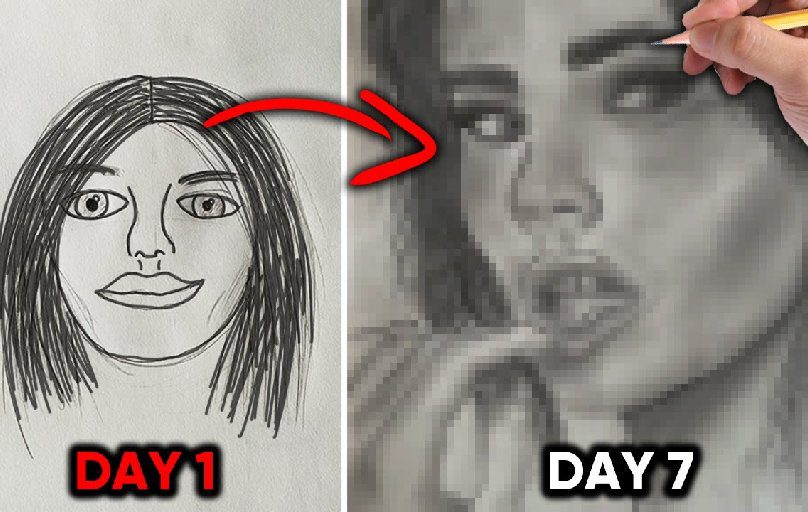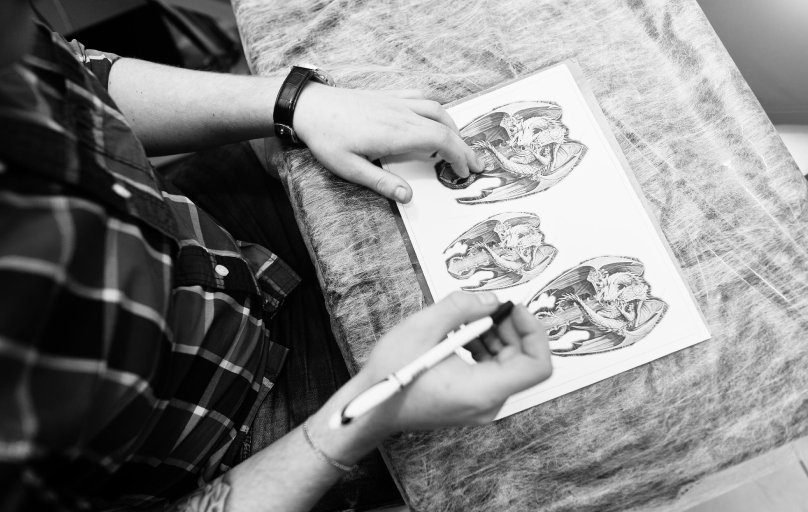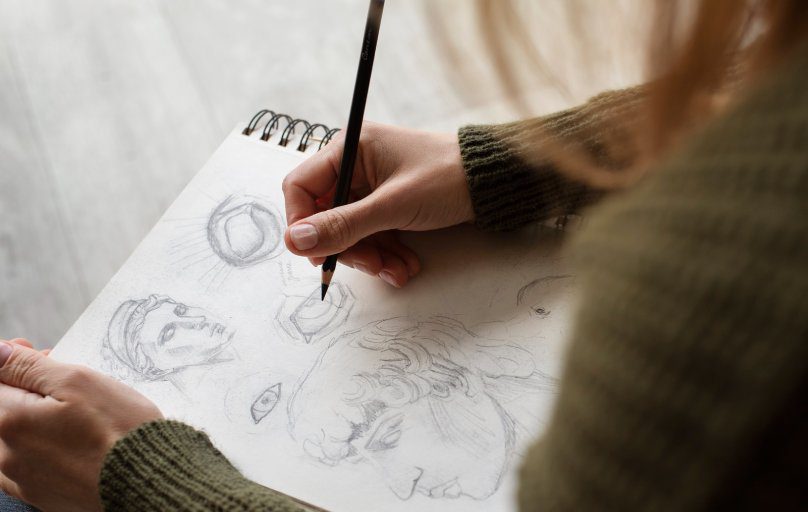Last Updated on July 5, 2023
Do you ever find yourself longing to express your creativity through drawing, but struggle to actually get started? Many individuals, regardless of their artistic background, often face challenges when it comes to initiating their artistic journey. Whether it’s lack of motivation, self-doubt, or simply not knowing where to begin, these hurdles can be overcome. In this article, we’ll explore practical tips and strategies to help you get yourself to draw and unleash your artistic potential.
Understanding Your Motivation
Before diving into the world of drawing, it’s essential to understand your personal motivations and goals. Take a moment to reflect on why you want to draw. Are you seeking a creative outlet? Do you wish to improve your artistic skills? Are you drawn to a specific drawing style or medium? Identifying your motivations will provide a solid foundation and help you set clear expectations for yourself.
Exploring different drawing styles and mediums can also be beneficial at this stage. Experiment with various techniques, such as pencil sketching, charcoal drawing, or digital art, to discover what resonates with you. This exploration will help you find joy and inspiration in the process of drawing.
Creating a Supportive Environment
Setting up a dedicated workspace is crucial in establishing a conducive environment for drawing. Find a comfortable and well-lit area where you can focus without distractions. Organize your drawing materials in a way that is easily accessible, allowing you to seamlessly transition into your creative practice.
In addition to a physical space, gather the necessary drawing materials that align with your preferred style and medium. This may include sketchbooks, pencils, erasers, paints, or digital drawing tablets. Having these tools readily available will eliminate any barriers when inspiration strikes.
Furthermore, seek out sources of inspiration that resonate with you. Surround yourself with artwork, visit galleries or online art platforms, and follow artists whose work captivates you. Immersing yourself in the world of art will ignite your creativity and provide a constant source of motivation.
Developing a Routine
Consistency is key when it comes to cultivating any skill, and drawing is no exception. Set aside regular time for drawing in your schedule. Whether it’s a few minutes every day or a dedicated block of time each week, establishing a routine will help make drawing a natural part of your life.
Consider incorporating drawing into your daily routine, such as sketching during your lunch break or drawing before bedtime. By integrating drawing into your existing schedule, you’ll be more likely to commit to your artistic practice.
Building Confidence
Building confidence in your drawing abilities is essential for overcoming self-doubt and allowing your creativity to flourish. Embrace the imperfections that may arise in your artwork and let go of harsh self-judgment. Remember, art is a journey, and each drawing is an opportunity to learn and grow.
Start with simple exercises to warm up and gradually progress to more complex subjects. There are numerous drawing tutorials and online resources available that can provide guidance and inspire new techniques. Additionally, seeking feedback and constructive criticism from trusted friends, mentors, or online art communities can help you gain valuable insights and improve your skills.
Exploring Different Techniques and Styles
Drawing encompasses a vast array of techniques and styles, each offering a unique artistic experience. Dive into tutorials, online courses, and art communities to explore different approaches to drawing. Experiment with various mediums and techniques, such as ink washes, stippling, or cross-hatching, to expand your creative repertoire. By broadening your knowledge and experimenting with different techniques, you’ll discover what resonates with you and develop your own unique style.
Studying the works of established artists can also provide valuable inspiration and guidance. Analyze their compositions, use of color, and brushstrokes. Allow yourself to be inspired by their artistry while also finding your own artistic voice.
Setting Challenges and Projects
Setting specific challenges and projects can be a great way to push yourself and keep your artistic practice engaging. Choose themes or subjects that interest you and challenge yourself to explore them through drawing. This could involve creating a series of portraits, capturing the essence of a particular landscape, or illustrating a story of your own creation.
Participating in art contests or themed projects can also provide motivation and a sense of community. Look for local or online art communities that organize such events and join in. The deadlines and shared experiences with fellow artists will inspire you to keep creating and improve your skills.
Collaborating with other artists can also be an excellent source of motivation and accountability. Find a drawing buddy or join a collaborative art project where you can share ideas, provide feedback, and inspire each other. The collective energy and support will propel you forward on your artistic journey.
Finding Support and Accountability
While art can be a solitary pursuit, connecting with other artists and seeking support is invaluable. Consider joining art classes or workshops in your local community or online platforms. These environments provide opportunities to learn from experienced instructors, receive feedback, and engage with fellow artists.
Art communities and forums, both online and offline, offer spaces to share your work, seek advice, and connect with like-minded individuals. Participate actively by sharing your progress, asking questions, and offering support to others. These communities often foster a sense of camaraderie and provide ongoing motivation and inspiration.
If you feel the need for more personalized guidance, consider finding a drawing mentor who can provide one-on-one support and tailored advice. A mentor can help you set goals, provide feedback, and encourage you through the ups and downs of your artistic journey.
Overcoming Creative Blocks
It’s not uncommon to experience creative blocks or periods of stagnation in your drawing practice. When faced with such challenges, it’s important to remember that they are a natural part of the creative process. Here are a few strategies to overcome creative blocks:
First, let go of perfectionism and the fear of failure. Allow yourself to make mistakes and view them as opportunities for growth. Embrace the journey of exploration and experimentation without overly focusing on the end result.
Try new techniques or subject matters to break out of your comfort zone. Explore different themes, experiment with different mediums, or draw from life if you primarily work from reference images. The process of exploring the unknown can reignite your creativity and open new artistic doors.
Don’t be afraid to take breaks when needed. Stepping away from your drawing for a short period can provide fresh perspectives and prevent burnout. Engage in activities that inspire you, such as visiting art exhibitions, taking walks in nature, or simply allowing yourself time to relax and recharge.
Seek alternative sources of inspiration beyond traditional art. Explore other art forms, such as photography, music, literature, or even film, which can spark new ideas and help you see your drawing practice from a different angle.
Celebrating Your Progress
Throughout your artistic journey, it’s essential to celebrate and acknowledge your progress. Keeping a sketchbook or portfolio is a wonderful way to track your improvement over time. Flip through the pages and witness how your skills have evolved, from early sketches to more refined pieces. Reflecting on your progress will boost your confidence and motivate you to continue pushing your boundaries.
Recognize and appreciate your own unique style. Embrace the individuality and authenticity of your artwork. Remember that art is subjective, and your artistic voice matters. Embrace your strengths, embrace your artistic voice, and let it shine through in your creations.
Sharing your work with others is a powerful way to gain feedback and encouragement. Display your art in online platforms, social media, or local art exhibitions. Don’t shy away from showcasing your talent and inviting constructive feedback. The support and positive responses you receive will fuel your motivation and inspire you to keep creating.
Conclusion
Drawing is a beautiful form of self-expression that holds immense potential for personal growth and creativity. By understanding your motivations, creating a supportive environment, developing a routine, building confidence, exploring different techniques and styles, setting challenges, seeking support and accountability, overcoming creative blocks, and celebrating your progress, you can cultivate a fulfilling drawing practice.
Remember, the journey of drawing is just as important as the end result. Embrace the process, enjoy the exploration, and let your artistic voice guide you. With dedication, practice, and a willingness to push beyond your comfort zone, you can unlock your creative potential and experience the joy of bringing your imagination to life through drawing.
So, grab your sketchbook, pick up your favorite drawing tool, and let your creativity flow. The world is waiting to see what you create.
Additional Tips & Infromation
The Role of Drawing Exercises in Skill Development
Drawing exercises play a crucial role in developing and honing your artistic skills. These exercises are designed to strengthen your hand-eye coordination, improve your observation skills, and enhance your ability to represent various shapes, forms, and textures accurately.
Some common drawing exercises include:
- Gesture Drawing: Gesture drawing involves capturing the essence and movement of a subject in a quick and spontaneous manner. It helps in developing fluidity and understanding the underlying structure of objects and figures.
- Contour Drawing: In contour drawing, you focus on drawing the outlines and defining the edges of the subject. This exercise improves your precision in capturing the proportions and details of the subject.
- Still Life Drawing: Still life drawing involves setting up a group of objects and drawing them from direct observation. This exercise helps you understand light and shadow, composition, and texture rendering.
- Value Studies: Value studies involve working with shades of gray to understand the different tonal values in a subject. By practicing value studies, you can improve your ability to create depth and dimension in your drawings.
Overcoming Common Drawing Challenges and How to Troubleshoot Them
Drawing comes with its own set of challenges. However, by understanding these challenges and implementing effective strategies, you can overcome them and continue to progress in your artistic journey.
- Lack of Confidence: Many aspiring artists struggle with self-doubt and lack confidence in their drawing abilities. To overcome this, start by embracing imperfection and focusing on the process rather than the end result. Practice regularly and celebrate small victories along the way to build confidence gradually.
- Proportions and Perspective: Proportions and perspective can be challenging aspects of drawing. To improve, study the principles of anatomy and perspective. Practice drawing from reference images or real-life observation to train your eye and develop a better understanding of spatial relationships.
- Lack of Creativity: Sometimes, artists struggle with a creative block or a lack of inspiration. To overcome this, explore different sources of inspiration such as nature, books, films, or personal experiences. Engage in activities outside of drawing that fuel your creativity and help generate new ideas.
- Difficulty with Shading and Textures: Shading and creating realistic textures can be challenging. Practice different shading techniques, such as cross-hatching or stippling, to develop your rendering skills. Study and analyze how light interacts with different surfaces to accurately depict textures.
Understanding Basic Elements of Composition in Drawing
Composition is the arrangement and organization of elements within a drawing to create a visually pleasing and impactful image. Understanding the basic elements of composition is essential for creating well-balanced and engaging drawings.
- Rule of Thirds: The rule of thirds suggests dividing the drawing area into a grid of nine equal parts by drawing two horizontal lines and two vertical lines. The points where these lines intersect are called the “power points.” Placing key elements along these lines or at the power points can create a more visually appealing composition.
- Balance: Balance refers to the distribution of visual weight in a drawing. It can be achieved through symmetrical or asymmetrical arrangements of elements. Aim for a sense of balance that feels visually pleasing and harmonious to the viewer’s eye.
- Focal Point: The focal point is the main point of interest in a drawing. It draws the viewer’s attention and establishes hierarchy within the composition. Consider using techniques such as contrast, size, or detail to emphasize the focal point and guide the viewer’s gaze.
- Leading Lines: Leading lines are lines or shapes within the drawing that guide the viewer’s eye and create a sense of movement. They can be actual lines or implied lines created by the arrangement of objects or elements. Utilize leading lines to direct the viewer’s attention and add visual interest to your composition.
- Negative Space: Negative space refers to the areas around and between the main subjects or objects in a drawing. It is equally important in composing a balanced and visually appealing composition. Pay attention to the shapes and relationships created by the negative space and use it effectively to enhance your composition.
Exploring the Use of Color in Drawing
Color adds depth, mood, and visual impact to drawings. While drawing is often associated with black and white, incorporating color opens up a whole new realm of artistic possibilities. Here are some aspects to consider when exploring the use of color in your drawings:
- Color Theory: Understanding color theory is crucial in creating harmonious and visually pleasing drawings. Learn about color relationships, such as complementary colors, analogous colors, and color temperature. Experiment with different color combinations to evoke different emotions and create visual impact in your drawings.
- Color Application Techniques: Experiment with different color application techniques such as layering, blending, or stippling to achieve various effects and textures. Practice controlling the intensity and saturation of colors to create depth and dimension in your drawings.
- Color Symbolism: Colors have symbolic meanings and associations. Consider the psychological impact of different colors and how they can enhance the narrative or mood of your drawing. Use color strategically to convey emotions, evoke specific reactions, or communicate themes and ideas.
- Mixed Media and Collage: Explore the combination of different mediums and materials to add texture and depth to your drawings. Experiment with incorporating elements of collage, such as textured papers, fabrics, or found objects, to create dynamic and visually rich compositions.
Drawing as a Form of Visual Storytelling
Drawing is a powerful tool for visual storytelling. It allows you to communicate ideas, narratives, emotions, and experiences visually. Here are some ways to use drawing as a form of visual storytelling:
- Narrative Composition: Create drawings that tell a story by capturing a sequence of events or depicting a specific moment. Consider the arrangement of elements, the use of gestures, and facial expressions to convey emotions and convey a narrative to the viewer.
- Character Design: Develop unique characters through drawing. Use visual cues such as clothing, expressions, and body language to communicate the personality, background, and motivations of the characters. Create a visual connection between the viewer and the characters to engage them in the story.
- Symbolism and Metaphor: Use symbolic imagery and metaphors in your drawings to convey deeper meanings and themes. Incorporate visual symbols, motifs, or allegorical elements that represent abstract concepts or ideas, adding layers of depth and intrigue to your storytelling.
- Sequential Art and Comics: Explore the art of sequential storytelling through the creation of comics or sequential art. Use panels, speech bubbles, and visual transitions to guide the viewer through a narrative. Experiment with pacing, panel composition, and the use of visual and textual elements to effectively convey the story.
Using Reference Images vs. Drawing from Life: Pros and Cons
When creating drawings, artists have the option to use reference images or draw from life. Each approach has its advantages and considerations. Here are some pros and cons of using reference images and drawing from life:
Using Reference Images:
Pros:
- Access to a wide range of subjects and references, including photographs, online images, or books.
- Ability to work at your own pace, allowing for more control over the drawing process.
- Useful for capturing specific details or complex compositions that may be challenging to observe in real-time.
- Provides a convenient option when drawing from life is not feasible.
Cons:
- May result in drawings that lack a sense of authenticity or personal interpretation.
- Reliance on reference images can limit your ability to develop observational skills and translate three-dimensional forms onto a two-dimensional surface.
- Risk of unintentionally copying the style or composition of the reference image without adding your unique artistic voice.
Drawing from Life:
Pros:
- Offers a direct and immersive experience, allowing you to observe and capture details firsthand.
- Enhances your ability to perceive and understand spatial relationships, proportions, and lighting.
- Provides opportunities to develop your observational skills and train your eye to see nuances and subtleties.
- Encourages personal interpretation and the infusion of your unique artistic style.
Cons:
- Requires access to suitable subjects or live models, which may not always be readily available.
- Constraints of time and changing lighting conditions may pose challenges in capturing specific details.
- Drawing from life can be more demanding in terms of skill and concentration.
Remember, the choice between using reference images and drawing from life ultimately depends on your artistic goals, preferences, and the specific requirements of your drawing. Both approaches offer valuable learning experiences and can be utilized in combination to broaden your artistic capabilities.
Frequently Asked Questions
I’ve always wanted to draw, but I struggle with motivation. How can I get myself to start drawing?
I often doubt my drawing abilities and fear failure. How can I overcome this self-doubt?
I often struggle with finding inspiration. How can I spark my creativity?
I find it challenging to come up with ideas for what to draw. Any suggestions?
Should I use reference images or draw from life?
How can I overcome creative blocks or periods of artistic stagnation?
How can I improve my drawing skills?
How can I make drawing a consistent part of my life?
How can I stay motivated when progress feels slow or when I face setbacks?
How can I find my own unique style as an artist?
Can I still learn to draw if I have no prior artistic experience?
About The Author

Pat Rowse is a thinker. He loves delving into Twitter to find the latest scholarly debates and then analyzing them from every possible perspective. He's an introvert who really enjoys spending time alone reading about history and influential people. Pat also has a deep love of the internet and all things digital; she considers himself an amateur internet maven. When he's not buried in a book or online, he can be found hardcore analyzing anything and everything that comes his way.




